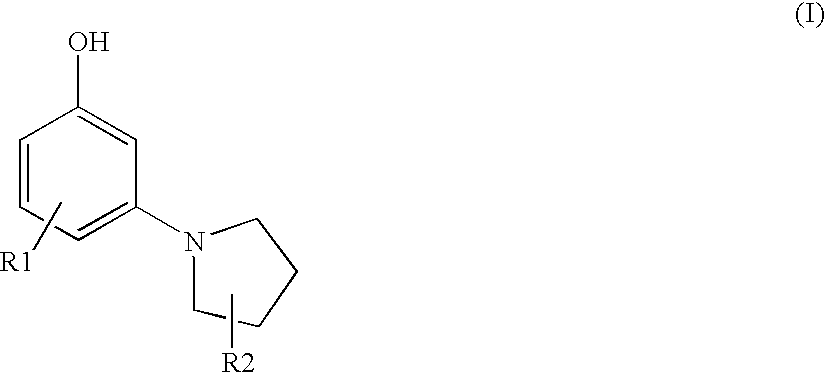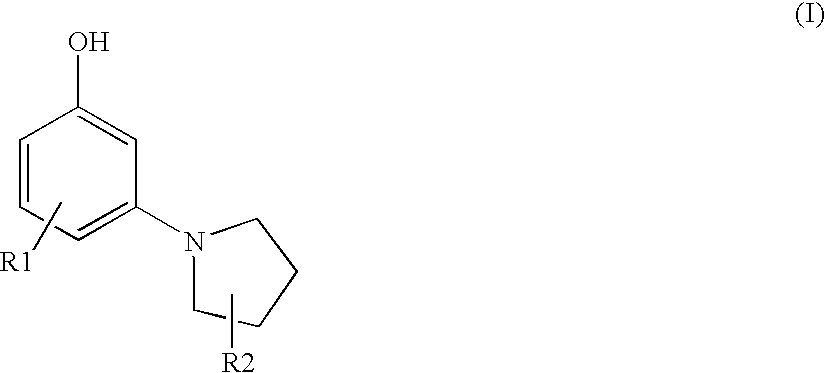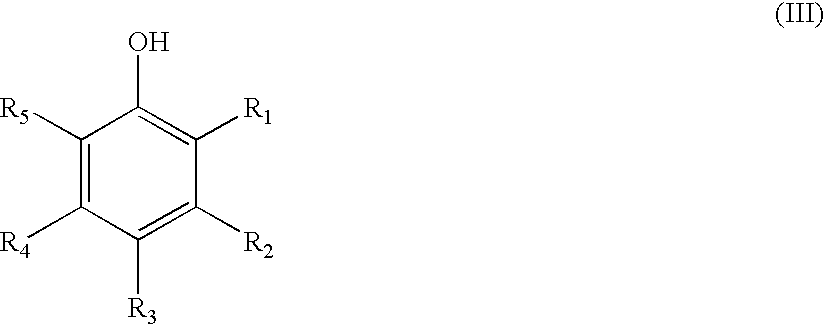Oxidizing hair coloring agents containing m-aminophenol derivatives
a technology of m-aminophenol and derivatives, which is applied in the direction of dyeing process, hair cosmetics, textiles and paper, etc., can solve the problems of not being able to meet the above-mentioned requirements in all aspects, and achieve the effect of being unusually resistant to light and washing
- Summary
- Abstract
- Description
- Claims
- Application Information
AI Technical Summary
Benefits of technology
Problems solved by technology
Method used
Image
Examples
example 1
Synthesis of 3-(1-pyrrolidinyl)phenol
A. Synthesis of 1-Bromo-3-methoxymethoxy-benzene
[0114]To a solution of 31.4 g (183.3 mmol) of 3-Bromo-phenol in 450 mL of dried acetonitrile a dispersion of 12 g (274.9 mmol) of sodium hydride (55% in oil) was added portionwise at 0° C. The mixture was then allowed to agitate at 0° C. for 3 hours. A solution of 25 g (210.8 mmol) of chloromethyl ethyl ether in 30 mL of acetonitrile was added dropwise, and the mixture was allowed to agitate overnight at room temperature (20-30° C.). The reaction mixture was then filtered and the filter cake was washed with a small amount of acetone. The combined filtrates were evaporated. This gave 32.3 g of 1-Bromo-3-methoxymethoxy-benzene. The resulting crude product was used in the next step without further purification.
[0115]1H-NMR (300 MHz, DMSO): 7.26-7.16 ppm (m 3H); 7.02 ppm (dd, 1H); 5.25 ppm (s, 2H); 3.65 ppm (q, 2H); 3.5 ppm (t, 3H).
B. Synthesis of 3-(1-pyrrolidinyl)phenol
[0116]7 g (30 mmol) of 1-Bromo-3...
examples 2 to 5
[0118]
0.00125moledeveloper according to Table 10.00125molecoupler of formula (I) according to Table 110.0gpotassium oleate (8% aqueous solution)10.0gammonia (22% aqueous solution)10.0gisopropanol0.3gascorbic acidto 100.0gwater
Immediately before use, 30 g of the above dye solution was mixed with 30 g of a 6% aqueous hydrogen peroxide solution. The mixture was then applied to bleached hair. After an exposure time of 30 minutes at 40° C., the hair was rinsed with water, washed with a commercial shampoo, and dried. The resulting color shades are shown in Table 1.
[0119]
TABLE 1ExampleDeveloperCoupler of Formula (I)Color21,4-diamino-benzene3-(1-pyrroldinyl)phenolnaturalblond31,4-diamino-2-methyl-3-(1-pyrroldinyl)phenolnaturalbenzeneblond41,4-diamino-2-(2-3-(1-pyrroldinyl)phenolnaturalhydroxyethyl)benzeneblondsulfate54,5-diamino-1-(2-3-(1-pyrroldinyl)phenolpurplehydroxyethyl)-1H-pyrazole sulfate
examples 6 to 25
[0120]
Xgcoupler S1 of formula (I) according to Table 2Ugprimary intermediates E1 to E8 according toTable 3Ygcoupler K1 to K21 according to Table 2Zgdirect dye D1 to D3 according to Table 410.0gof potassium oleate (8% aqueous solution)10.0gof ammonia (22% aqueous solution)10.0gethanol0.3gascorbic acidbalance to 100.0gwater
Immediately before use, 30 g of the foregoing dye solution was mixed with 30 g of a 6% aqueous hydrogen peroxide solution. The mixture was then applied to bleached hair. After an exposure time of 30 minutes at 40° C., the hair was rinsed with water, washed with a commercial shampoo, and dried. The dye quantity used and the color results are presented in Table 5.
[0121]
TABLE 2Coupler SubstancesS13-(1-pyrrolidinyl)phenolK11,3-diaminobenzeneK22-amino-4-(2′-hydroxyethyl)amino-anisol-sulfateK32,4-diamino-1-(2′-hydroxyethoxy)benzene-sulfateK42,4-diamino-5-fluoro-toluene-sulfateK53-amino-2-methylamino-6-methoxy-pyridinK63,5-diamino-2,6-dimethoxy-pyridin-dihydr...
PUM
 Login to View More
Login to View More Abstract
Description
Claims
Application Information
 Login to View More
Login to View More - R&D
- Intellectual Property
- Life Sciences
- Materials
- Tech Scout
- Unparalleled Data Quality
- Higher Quality Content
- 60% Fewer Hallucinations
Browse by: Latest US Patents, China's latest patents, Technical Efficacy Thesaurus, Application Domain, Technology Topic, Popular Technical Reports.
© 2025 PatSnap. All rights reserved.Legal|Privacy policy|Modern Slavery Act Transparency Statement|Sitemap|About US| Contact US: help@patsnap.com



